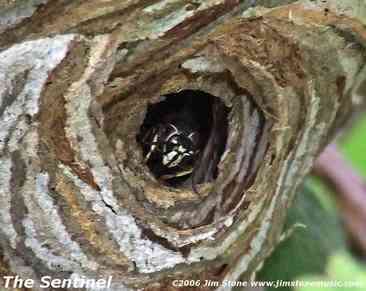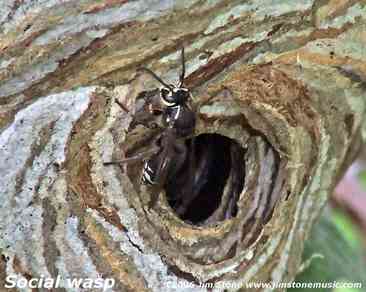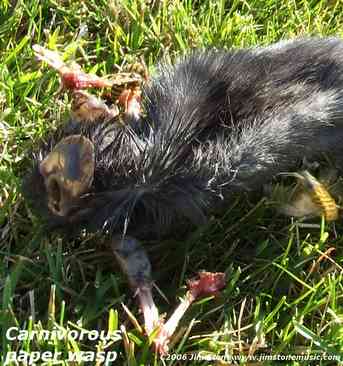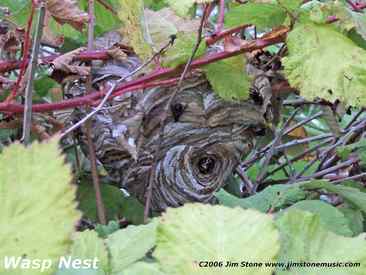 |   For more critters, visit the main gallery through the link at the bottom of this page
I always wanted to see a wasp nest like this, and despite being outdoors looking for critters a lot I had never seen one this nice. I was out picking blackberries in Vancouver when I found this nest, right in an un-occupied area where some train tracks went. It is by far the best I have ever seen. Had I disturbed it, it could have easily been fatal, these photos were almost as spooky to get as the rattlesnake photo you can find in the main gallery as I once again pushed it to the limit to get the shot. This particular type of wasp has a bad sting. These are social wasps. There are many types of wasps - many of which are solitary. But this particular species is social, and like honey bees have large colonies with many members. I estimate that this hive had at least 200. This particular type of social wasp is called a bald faced hornet (Dolichovespula maculata) Like honey bees, these paper wasps have queens and workers. They cooperate in caring for the young, and have life spans that overlap the next generation. So there is a consistent number of wasps in a hive, which can grow and add new members while the old ones are still alive. A typical social wasp queen lives through the winter and in the spring builds a small hive and raises the first brood herself. Once the first brood is raised, the queen's responsibilities change and she mainly gets fat, lays eggs and lets the workers do the rest. Female worker wasps gather food and take care of the young when they hatch from eggs. Sex is determined by whether or not an egg is fertilized; un-fertilized eggs make males and fertilized eggs make females. If you look closely at the picture below, especially the large clicked photo, you should be able to see that these wasps roll their wings up when not in use; they do not fold them and hold them against their bodies as other insects and bees do.
A paper wasp makes its nest by chewing up wood and spitting it back out with a special glue mixed in. When the wood fibers dry it makes paper that can hold up to moisture and also provide structural stability for the hive. Inside the nest, there are horizontal combs similar in shape to honeycombs, layered one above the other like stories in a building. So this hive has several floors. Paper wasps are found throughout North America and would rather chew up paper than wood, so it will ruin speakers that have paper cones if it can find them - something I learned through hard experience. I once had a nice pair of speakers in the garage and the wasps ate the cones perfectly clean off and left only the voice coils. Bald faced hornets are carnivorous and do not care about flowers. They eat insects and meat. They are mostly predatory and can catch insects while in flight. Inside the nest, female workers feed the larvae chewed up insects. Many of the carnivorous wasps will also eat the meat from dead animals. In this photo you can see another species of wasps, the common yellowjacket (vespula vulgaris) cleaning the meat off a dead rat. These are paper wasps of a different subspecies, which have a different pattern than the bald faced hornets.
I pulled this previously unwanted image impromptu right out of my archive. Sort of lets you know how many pictures I must have taken before I could just pull one like this! It amazed me to see how clean they got the bones, they take everything. Most people have seen these wasps on their plate at picnics. So I guess you now have more than flies to worry about. They seem to like sweet things also, but what they really go for is meat. That is why these wasps cannot replace honey bees, these wasps serve a purpose by cleaning up dead animals and getting rid of insects. They are not pollinators. These wasps are in the same order as ants, bees, and sawflies. That makes sense, because we all know that bees and ants also have colonies and queens, just like these wasps do. It is important to note however that there are various species of solitary wasps and bees, not all species have hives. But among the colony builders certain things are always true. They all have a queen. They all have workers, and they all have male drones. The male drones in this hive serve only one purpose; - to mate with the queen. To wrap things up, here is a picture of the hive in full perspective.
|  |
 Click for a better picture of this
Click for a better picture of this  Click for a better picture of this
Click for a better picture of this  Click to see these
Click to see these  click the link for a better picture of this
click the link for a better picture of this